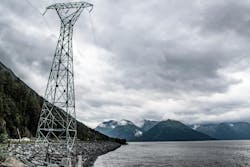Department of Energy Spending Up to $200M Connecting Remote Microgrids
The U.S. Department of Energy (DOE) is currently accepting proposals for transmission projects that would connect remote and isolated microgrids to each other or to existing transmission corridors in Alaska, Hawaii and U.S. territories.
Up to $200 million is available for these projects through the Transmission Facilitation Program (TFP), a $2.5 billion revolving fund administered by the Building a Better Grid Initiative as part of the Bipartisan Infrastructure Law.
The TFP has three funding mechanisms available: capacity contracts, DOE loans and DOE participation in public-private partnerships. The newly issued request for proposals falls into the public-private partnership category, meaning the DOE would be an equity partner in the selected projects, providing both capital and technical assistance.
The DOE will choose projects that ultimately work to address the electricity challenges faced by remote and isolated communities that are often confronted by extreme weather conditions and rising energy costs.
According to the DOE, the projects will not only enhance grid reliability and resilience, but they will also expand access to clean and more affordable energy for these communities.
“Building transmission projects to connect isolated microgrids allows us to leverage energy resources and systems already in place to increase electric reliability and resilience for these at-risk communities,” said Maria Robinson, director of the Grid Deployment Office at the DOE.
Will the cost/benefit analysis make sense in Alaska?
The projects selected for this round of TFP funding must use the money to interconnect existing microgrids to each other or to an existing transmission system – they cannot be used to build generation or distribution system facilities.
While in some instances interconnecting existing microgrids will likely make financial sense, it is unclear how much impact these transmission projects will have in remote Alaskan communities, according to Peter Asmus, senior adviser, microgrid strategy and thought leadership at the Alaska Center for Energy and Power and executive director of the Alaska Microgrid Group.
Alaska does not have a conventional grid infrastructure like the rest of the continental U.S. Rather, the state is powered by a plethora of microgrids, some of which are interconnected to form larger regional grids.
The largest regional grid is what’s known as the “Railbelt Grid” because it runs from Fairbanks to Anchorage and on to the Kenai Peninsula roughly along the same path as the Alaska Railroad.
But most of the microgrids in Alaska are small, with many serving communities of less than 100 people.
“Many of the remote microgrids in Alaska are so small or so far away from each other that it may be difficult to justify connecting them with transmission lines that would often have to traverse sensitive environmental habitats,” Asmus said in a statement to Microgrid Knowledge.
That means the success of any project that results from a TFP-funded proposal will largely depend on how much the benefits outweigh the costs.
Alaska is used to conducting cost-benefit analyses when it comes to energy. Because of the high cost of transporting diesel fuel to remote areas, many communities are opting to build renewable microgrids because renewable electricity is cheaper to generate.
Asmus pointed to the microgrid that powers Kodiak Island as an example. The island “runs on over 99% renewable energy annually. Wind, hydro, batteries and flywheels are all employed in this microgrid.” The microgrid was a finalist for the 2021 Microgrid Greater Good Awards.
Similarly, the remote town of Cordova’s microgrid has a high percentage of renewables. But there are no roads in or out of the community, so building transmission lines to other communities would be a significant undertaking, Asmus said.
“I would guess there are exceptions to this generalization but trying to connect the more than 200 remote and fully islanded microgrids in a state the size of Alaska does not seem to me to be a realistic strategy,” he added.
Time will tell if and how the TFP funds will impact remote communities in Alaska. The deadline for applications is May 31, and the DOE expects to announce which projects it has selected in October.








